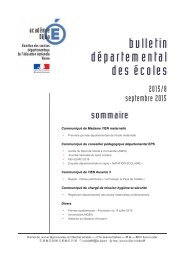agrl_innovations_in_ssa.pdf?utm_content=buffercb41d&utm_medium=social&utm_source=twitter
agrl_innovations_in_ssa.pdf?utm_content=buffercb41d&utm_medium=social&utm_source=twitter
agrl_innovations_in_ssa.pdf?utm_content=buffercb41d&utm_medium=social&utm_source=twitter
Create successful ePaper yourself
Turn your PDF publications into a flip-book with our unique Google optimized e-Paper software.
and improv<strong>in</strong>g NRM. As such, the IP structure and activities are prov<strong>in</strong>g to be a useful model for<br />
the implementation of Government’s ASWAp <strong>in</strong> the respective districts.<br />
The IP approach has proved very useful for empower<strong>in</strong>g participat<strong>in</strong>g stakeholders <strong>in</strong> rural<br />
communities. However the expectations and aspirations of IP members vary, mean<strong>in</strong>g that the<br />
IP is ever-evolv<strong>in</strong>g or chang<strong>in</strong>g with a potential to become <strong>in</strong>creas<strong>in</strong>gly relevant. The benefits<br />
enjoyed by farmers are numerous, <strong>in</strong>clud<strong>in</strong>g access to <strong>in</strong>puts, loans, market and power through<br />
collective action. Each learn<strong>in</strong>g site has proved to a be focus for IP activities for farmers from<br />
both host villages and surround<strong>in</strong>g communities as well as visit<strong>in</strong>g NGOs, who arrange exchange<br />
visits for farmers from other areas.<br />
Zambia’s conservation agriculture<br />
Pilot <strong>in</strong>itiatives to <strong>in</strong>troduce more susta<strong>in</strong>able<br />
farm<strong>in</strong>g practices <strong>in</strong> Africa are many, although<br />
documentation of results and lessons<br />
learned is scarce. There is, however, grow<strong>in</strong>g<br />
understand<strong>in</strong>g among stakeholders that<br />
susta<strong>in</strong>able agriculture needs to be based on<br />
simple core pr<strong>in</strong>ciples that are embodied <strong>in</strong><br />
CA. This Zambia case study concerns the role<br />
of CA <strong>in</strong> <strong>in</strong>creas<strong>in</strong>g agricultural productivity<br />
and support<strong>in</strong>g diversification to other crops,<br />
particularly legumes.<br />
A Conservation Farm<strong>in</strong>g Unit (CFU) was established <strong>in</strong> 1995 as an <strong>in</strong>dependent unit<br />
with<strong>in</strong> the Zambia National Farmers Union (ZNFU) to develop and promote the adoption<br />
of CA. This was <strong>in</strong> response to the realisation that even <strong>in</strong> years of good ra<strong>in</strong>fall the<br />
majority of smallholder farmers were food-<strong>in</strong>secure. At the same time it was argued<br />
that conventional cultivation practices were lead<strong>in</strong>g to decl<strong>in</strong><strong>in</strong>g productivity, <strong>in</strong>creas<strong>in</strong>g<br />
food <strong>in</strong>security, <strong>in</strong>creas<strong>in</strong>g poverty, and serious environmental degradation, not only <strong>in</strong><br />
Zambia but <strong>in</strong> the region as a whole. There was clearly an urgent need to identify and<br />
promote more productive and more susta<strong>in</strong>able farm<strong>in</strong>g practices.<br />
CFU strongly believed that these problems could be addressed by adopt<strong>in</strong>g CA practices.<br />
Management practices were developed for hand hoe, animal-drawn and tractor fam<strong>in</strong>g<br />
systems, <strong>in</strong>volv<strong>in</strong>g grow<strong>in</strong>g crop rotations that <strong>in</strong>cluded legumes with options for the use<br />
of herbicides for weed control and trees to harvest soil nutrients and improve human<br />
nutrition. In 1999 the Zambian M<strong>in</strong>istry of Agriculture and Cooperatives (MoA&C)<br />
endorsed the promotion of CA as national extension policy and by 2003 studies were<br />
confirm<strong>in</strong>g that CA was f<strong>in</strong>ancially attractive, although its effectiveness varied across<br />
crops and over time due to weather fluctuations. Today an estimated 175,000 farmers<br />
are practis<strong>in</strong>g CA.<br />
The case studies: Southern Africa 59






